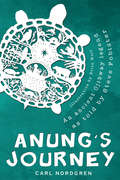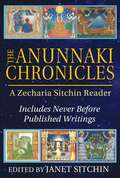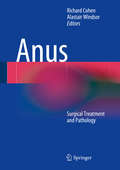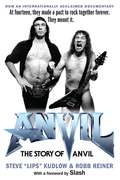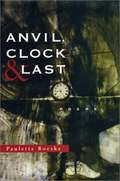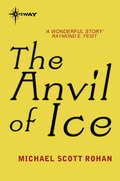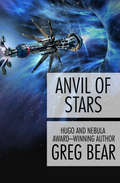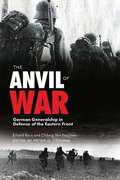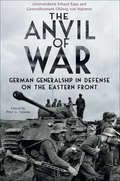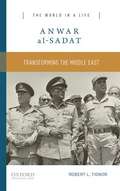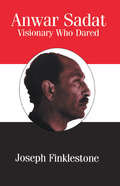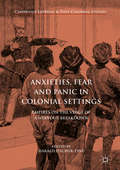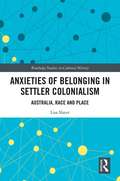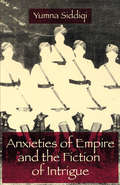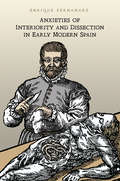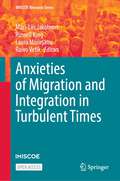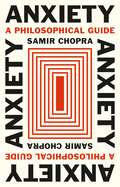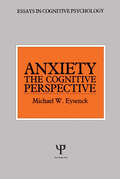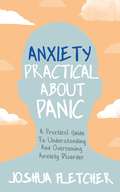- Table View
- List View
Anung's Journey: An ancient Ojibway legend as told by Steve Fobister
by Brita Wolf Carl NordgrenThis ancient Ojibway legend predates contact with European settlers, but the drummer boy and the people he meets at the end of his journey couldn't be more familiar to modern culture.When the orphaned Anung sets out on his vision quest, he sees clearly that his purpose in life is to find the greatest chief of all and tell him of the many acts of kindness the mothers and fathers of the village have given to Anung. When the people of his village learn of the vision, they are proud of him. For every man of the village loves Anung as his son. Every woman is his mother. They believe Gitche Manitou, the great creator, has chosen their son for a special journey. In his quest to find the greatest chief, Anung travels through the 13 tribes of the First Nations, across forests, plains, water, and desert. Along the way, he is accompanied by Turtle, the interpreter of all languages. He finds friends in the most unlikely of places--a squirrel's nest, a mother bear's den, and a city filled with people from every tribe. At each stop, Anung and his drum sing of his mothers and fathers and his quest to meet the greatest chief. What Anung finds at the end of his journey will both surprise and thrill readers of all ages. This ancient legend, told in the beautifully poetic style of Carl Nordgren, begs to be read aloud and savored.
The Anunnaki Chronicles: A Zecharia Sitchin Reader
by Janet Sitchin Zecharia SitchinAn insider’s look into the decades of research behind Zecharia Sitchin’s books as well as an in-depth overview of his theories and discoveries • Includes carefully selected chapters from the Earth Chronicles series as well as never-before-published letters, articles, and lectures • Each piece includes an introduction, offering context and insight into Sitchin’s passionate work and revealing the man behind the theories • Explains the genesis of The 12th Planet, the Anunnaki influences on the Sumerian civilization, the orbit of Nibiru, the prehistory of the Americas, the extraterrestrial origins of modern man, and much more What if the tales from the Old Testament and other ancient writings, such as those from Sumer, Babylon, Egypt, and Greece, were not myths or allegory but accounts of actual historical events? Known for his ability to read and interpret ancient Sumerian and Akkadian clay tablets, Zecharia Sitchin (1920-2010) took the words of our most ancient ancestors as fact and, through decades of meticulous research, showed that they revealed a coherent narrative about the true origins of humanity and civilization. Drawing both widespread interest and criticism, his Earth Chronicles series of books, beginning with The 12th Planet, detailed how humanity arose after the arrival of the Anunnaki (“those who from Heaven to Earth came”), alien “gods” who created modern man in their own image and imparted gifts of civilizing knowledge. Providing an insider’s look into the decades of research behind Zecharia Sitchin’s complete works as well as an in-depth overview of his theories, this collection includes carefully selected chapters from the Earth Chronicles series as well as never-before-published letters, articles, and lectures. We learn about the genesis of The 12th Planet in “The Book as a Story,” the Sumerians and their Anunnaki influences in “The Sudden Civilization,” the orbit of Nibiru in “UFOs, Pyramids, and the 12th Planet,” the prehistory of the Americas in “Cities Lost and Found,” the extraterrestrial origins of modern man in “The Cosmic Connection--DNA,” and much more. We get to read never-before-published lectures, culled from Sitchin’s decades of presentations, as well as the article that spurred the writing of There Were Giants Upon the Earth. Each piece includes an introduction by Sitchin’s niece, offering context and insight into Sitchin’s passionate work. These introductions reveal the man behind the theories, a world traveler known for his scholarship, dry humor, and precisely chosen words. If his theories are true, as Sitchin wholeheartedly believed, then this collection presents some of the most important knowledge we have of our origins and future.
Anus: Surgical Treatment and Pathology
by Richard Cohen Alastair WindsorThere is an increase in specialisation within general surgery and now even within its sub specialties. Colorectal surgery is probably the largest of the subspecialties of general surgery, and one of the areas where trainees and consultant general /colorectal surgeons are least confident is in their understanding of the anatomy, physiological pathology and management of the anal canal and pelvis. Currently available there are books on the market centred around the general management of colorectal disease, but the time is now right for a definitive text on the anal canal and pelvis specifically.
Anvil!
by Robb Reiner Lips ReinerIn the early seventies, when Led Zeppelin and Black Sabbath ruled the world, Steve "Lips" Kudlow and Robb Reiner, two young Jewish boys from the northern suburbs of Toronto, vowed to rock together forever. A decade later, their band Anvil released one of the heaviest records in music history, Metal on Metal, which influenced a whole musical generation, including the world-dominating bands Metallica, Slayer, and Anthrax. Yet while these bands went on to sell millions of records, Anvil slipped straight into obscurity. Was it too much sex and drugs and not enough rock 'n' roll? Was it the menagerie of pets that accompanied them on tour? Was it Lips's penchant for using a dildo to play his guitar (with integrity) and writing political songs like "Show Us Your T***"? Or was it their uncanny knack for setting themselves on fi re whenever a record company executive was watching? Now, almost thirty years later, like a real-life Spinal Tap, these unlikely musical heroes are still rocking, and still chasing their dream. Written in their own words, Anvil!: The Story of Anvil charts the rise, fall, and eventual triumph of two men whose indestructible friendship, talent, and determination took them on a unique journey in the world of rock. A bittersweet and frequently hilarious hymn to the human spirit, played loud in power chords, it is a story of true brotherly love, being a lifer, living the dream, and never giving up.
Anvil, Clock and Last
by Paulette RoeskeLike the seismic shifts and explosions that reveal hidden features of the earth, Paulette Roeske's poems record upheavals and jolts of self-knowledge in the seeming-solid world where we hammer out our lives. The labor of poetic creation cracks open the self: "How could I have guessed the geode's / rare concentrics, its brilliant sharp-toothed crystals / ... It was hope that returned me to the hammer / to lay open the bright interiors / I could have overlooked". Readers will find that hope rewarded as the poet wields the tools of time and legacy -- anvil, clock, and last -- to craft meticulous verses yielding glittering insight. The clock is omnipresent in this collection, signaling the exquisite tension between the desire to erase the past and the urge to devour all experience. A father's legacy to a daughter is inescapable: "He's left his mark on everything / time filtered through his hands. He's left / it all to me". But Roeske's rare intensity and depth of thought produce poems of mortality and loss balanced by the unexpected appearance of love. After guiding us through the hard forging of a self, the poet places us on the "platform, springboard, raft, or tippy boat", urging us to see love, like all life's experiences, as "a place to fling yourself into", eyes open, fingers crossed.
The Anvil of Ice
by Michael Scott RohanThe chronicles of THE WINTER OF THE WORLD echo down the ages in half-remembered myth and song - tales of mysterious powers of the Mastersmiths, of the forging of great weapons, of the subterranean kingdoms of the duergar, of Gods who walked abroad, and of the Powers that struggled endlessly for dominion. In the Northlands, beleaguered by the ever-encroaching Ice and the marauding Ekwesh, a young cowherd, Alv, saved from the raiders by the mysterious Mastersmith, discovers in himself an uncanny power to shape metal - but it is a power that may easily be turned to evil ends, and on a dreadful night Alv flees the Mastersmith, and embarks on the quest to find both his own destiny, and a weapon that will let him stand against the Power of the Ice.
The Anvil of Ice (The Winter of the World #1)
by Michael Scott RohanMichael Scott Rohan's Winter of the World trilogy, the story revolves around Alv a cowherd whose childish wishes for the destruction of his hated home is fulfilled when the Ekwesh raiders appear, their boats low on the sea. The boy is claimed by the Mastersmith travelling with these barbarians. Displaying a potential for smithcraft, Alv makes the long travel to the Mastersmith's reclusive tower that clutches the mountains opposite the relentless grinding of the Ice.
The Anvil of Ice
by Michael Scott RohanThe chronicles of THE WINTER OF THE WORLD echo down the ages in half-remembered myth and song - tales of mysterious powers of the Mastersmiths, of the forging of great weapons, of the subterranean kingdoms of the duergar, of Gods who walked abroad, and of the Powers that struggled endlessly for dominion. In the Northlands, beleaguered by the ever-encroaching Ice and the marauding Ekwesh, a young cowherd, Alv, saved from the raiders by the mysterious Mastersmith, discovers in himself an uncanny power to shape metal - but it is a power that may easily be turned to evil ends, and on a dreadful night Alv flees the Mastersmith, and embarks on the quest to find both his own destiny, and a weapon that will let him stand against the Power of the Ice.
Anvil of Stars (Forge of God #2)
by Greg BearThe &“provocative and entertaining follow-up&” to The Forge of God: Exiled from their planet, humans unite with one alien race in the fight against another (Publishers Weekly). The Ship of the Law travels the infinite enormity of space, carrying eighty-two young people: fighters, strategists, scientists—and children. After one alien culture destroyed their home, another offered the opportunity for revenge in the form of a starship built from fragments of the Earth&’s corpse, a ship they now use to scour the universe in search of their enemy. Working with sophisticated nonhuman technologies that need new thinking to comprehend them, they&’re cut off forever from the people they left behind. Denied information, they live within a complex system that is both obedient and beyond their control. They&’re frightened. And they&’re waging war against entities whose technologies are unimaginably advanced and vast, and whose psychology is ultimately, unknowably alien. In Anvil of Stars, the multimillion-selling, Nebula Award–winning author of Eon and other science fiction masterpieces &“fashions an action-packed and often thrilling plot; by using each of the well-depicted alien races to mirror human behavior, he defines what it means to be Homo sapiens. . . . A gripping story&” (Publishers Weekly).
Anvil of Stars (Forge of God #2)
by Greg BearThe &“provocative and entertaining follow-up&” to The Forge of God: Exiled from their planet, humans unite with one alien race in the fight against another (Publishers Weekly). The Ship of the Law travels the infinite enormity of space, carrying eighty-two young people: fighters, strategists, scientists—and children. After one alien culture destroyed their home, another offered the opportunity for revenge in the form of a starship built from fragments of the Earth&’s corpse, a ship they now use to scour the universe in search of their enemy. Working with sophisticated nonhuman technologies that need new thinking to comprehend them, they&’re cut off forever from the people they left behind. Denied information, they live within a complex system that is both obedient and beyond their control. They&’re frightened. And they&’re waging war against entities whose technologies are unimaginably advanced and vast, and whose psychology is ultimately, unknowably alien. In Anvil of Stars, the multimillion-selling, Nebula Award–winning author of Eon and other science fiction masterpieces &“fashions an action-packed and often thrilling plot; by using each of the well-depicted alien races to mirror human behavior, he defines what it means to be Homo sapiens. . . . A gripping story&” (Publishers Weekly).
Anvil of the Gods
by Fred McclementA rather dated look at the dangers of flying airliners into thunderstorms. Turbulents, wind sheers and other phenomena are discussed. Photo captions somewhat impare readability.
The Anvil Of The World
by Kage BakerMr. Smith begins a long series of adventures by agreeing to become caravan master for his cousin's company.
The Anvil of War: German Generalship in Defense of the Eastern Front
by Peter G. Tsouras Erhard Rauss Oldwig Von NatzmerAn unprecedented look at German operations on the Russian Front during World War II. The Anvil of War collects US Army–commissioned reports by two highly ranked German officers who served on the disastrous Russian Front: Military Improvisations During the Russian Campaign, German Defense Tactics Against Russian Breakthroughs by Erhard Raus, and Operations of Encircled Forces by Oldwig Von Natzmer. The reports show how the Germans adapted techniques to cope with their enemy’s great numerical superiority and managed to delay and sometimes drive back the steamroller Russian forces during the German retreat. The significance of the material detailing the Germans’ vast experience on the Russian Front was emphasized with the onset of the Cold War and the perceived Soviet threat to Europe. Written as part of a US Army program instigated after World War II by Col. S. L. A. Marshall of the Army Historical Division, who was convinced that no record of the war could be complete without the input of the German commanding officers and their main staff officers, these reports offer an invaluable record of German operations for historians and general readers. Compiled, edited, and introduced by renowned military historian Peter G. Tsouras, The Anvil of War stands as one of the great historical records of one of the largest military confrontations in history.
The Anvil of War: German Generalship in Defence on the Eastern Front
by Oldwig Von Natzmer Erhard RaussAn unprecedented look at German operations on the Russian Front during World War II.The Anvil of War details the German strategies and tactics employed by the commanders on the cataclysmic Russian Front in the Second World War. Monographs by two German officers who served in Russia – Military Improvisations during the Russian Campaign and German Defense Tactics against Russian Breakthrough by General Erhard Rauss, and Operations of Encircled Forces by Generalleutnant Oldwig von Natzmer – show how the Germans adapted techniques to cope with their enemy&’s great numerical superiority, and managed to delay and sometimes drive back the &“steamroller Russian forces during the German retreat in 1945.&” These reports were written as part of a U.S. Army program instigated after the war by Colonel S.L.A. Marshall of the Army Historical Division, who was convinced that no record of the war could be complete without the input of German commanding officers and their main staff officers. The significance of the material detailing the Germans vast experience of fighting the Soviets was emphasized with the fear of a Russian attack during the Cold War.
Anwar Al-sadat: Transforming The Middle East (The World in a Life)
by Robert TignorPart of The World in a Life series, this brief, inexpensive text provides insight into the life of Anwar al-Sadat, one of the most transformative figures in Middle Eastern and world history. Little was expected of Sadat, as he came to power after the death of Egypt's powerful modernizing leader, Gamal Abdel Nasser. However, he left an unparalleled mark on Egypt, the Middle East, and Cold War relations. He surprised the Israelis by starting the 1973 war, crossing the Suez Canal into Sinai. Though eventually Egypt was forced to sue for peace, Sadat won the support and praise of the Americans. His chief American supporters at the time were President Richard Nixon and Secretary of State Henry Kissinger. Not content with this partial military success, Sadat traveled to Jerusalem in 1977 to address the Israeli Knesset (parliament), marking the first time that an Arab leader had traveled to Israel and openly negotiated with the Israelis. He followed this trip with a peace treaty with Israel in 1979, signed between Prime Minister Menachem Begin and himself and brokered by President Jimmy Carter. In short, Sadat broke Egypt's dependence on the Soviet Union, established strong relations with the United States, and recognized the state of Israel--all of these transformative events in Middle Eastern and world history.
Anwar Sadat: Visionary Who Dared
by Joseph Finklestone Joseph Finklestone ObeAnwar Sadat's life was shaped by Egypt's national struggle and the conflict between the Arab world and Israel. This biography charts his progress from fanatical nationalist to President of Egypt, and from world statesman to tragic hero, who gave his life in the cause of peace.
Anxieties, Fear and Panic in Colonial Settings: Empires on the Verge of a Nervous Breakdown (Cambridge Imperial and Post-Colonial Studies Series)
by Harald Fischer-TinéThis book argues that the history of colonial empires has been shaped to a considerable extent by negative emotions such as anxiety, fear and embarrassment as well as by the regular occurrence of panics. The case studies it assembles examine the various ways in which panics and anxieties were generated in imperial situations and how they shook up the dynamics between seemingly all-powerful colonizers and the apparently defenceless colonized. Drawing from examples of the British, Dutch and German colonial experience, the volume sketches out some of the main areas (such as disease, native ‘savagery’ or sexual transgression) that generated panics or created anxieties in colonial settings and analyses the most common varieties of practical, discursive and epistemic strategies adopted by the colonisers to curb the perceived threats.
Anxieties of Belonging in Settler Colonialism: Australia, Race and Place (Routledge Studies in Cultural History #65)
by Lisa SlaterThis book analyses the anxiety "well-intentioned" settler Australian women experience when engaging with Indigenous politics. Drawing upon cultural theory and studies of affect and emotion, Slater argues that settler anxiety is an historical subjectivity which shapes perception and senses of belonging. Why does Indigenous political will continue to provoke and disturb? How does settler anxiety inform public opinion and "solutions" to Indigenous inequality? In its rigorous interrogation of the dynamics of settler colonialism, emotions and ethical belonging, Anxieties of Belonging has far-reaching implications for understanding Indigenous-settler relations.
Anxieties of Empire and the Fiction of Intrigue
by Yumna SiddiqiFocusing on late nineteenth- and twentieth-century stories of detection, policing, and espionage by British and South Asian writers, Yumna Siddiqi presents an original and compelling exploration of the cultural anxieties created by imperialism. She suggests that while colonial writers use narratives of intrigue to endorse imperial rule, postcolonial writers turn the generic conventions and topography of the fiction of intrigue on its head, launching a critique of imperial power that makes the repressive and emancipatory impulses of postcolonial modernity visible.Siddiqi devotes the first part of her book to the colonial fiction of Arthur Conan Doyle and John Buchan, in which the British regime's preoccupation with maintaining power found its voice. The rationalization of difference, pronouncedly expressed through the genre's strategies of representation and narrative resolution, helped to reinforce domination and, in some cases, allay fears concerning the loss of colonial power. In the second part, Siddiqi argues that late twentieth-century South Asian writers also underscore the state's insecurities, but unlike British imperial writers, they take a critical view of the state's authoritarian tendencies. <P><P>Such writers as Amitav Ghosh, Michael Ondaatje, Arundhati Roy, and Salman Rushdie use the conventions of detective and spy fiction in creative ways to explore the coercive actions of the postcolonial state and the power dynamics of a postcolonial New Empire. Drawing on the work of leading theorists of imperialism such as Edward Said, Frantz Fanon, and the Subaltern Studies historians, Siddiqi reveals how British writers express the anxious workings of a will to maintain imperial power in their writing. She also illuminates the ways South Asian writers portray the paradoxes of postcolonial modernity and trace the ruses and uses of reason in a world where the modern marks a horizon not only of hope but also of economic, military, and ecological disaster.
Anxieties of Interiority and Dissection in Early Modern Spain
by Enrique FernandezAnxieties of Interiority and Dissection in Early Modern Spain brings the study of Europe's "culture of dissection" to the Iberian peninsula, presenting a neglected episode in the development of the modern concept of the self. Enrique Fernandez explores the ways in which sixteenth and seventeenth-century anatomical research stimulated both a sense of interiority and a fear of that interior's exposure and punishment by the early modern state.Examining works by Miguel de Cervantes, María de Zayas, Fray Luis de Granada, and Francisco de Quevedo, Fernandez highlights the existence of narratives in which the author creates a surrogate self on paper, then "dissects" it. He argues that these texts share a fearful awareness of having a complex inner self in a country where one's interiority was under permanent threat of punitive exposure by the Inquisition or the state. A sophisticated analysis of literary, religious, and medical practice in early modern Spain, Fernandez's work will interest scholars working on questions of early modern science, medicine, and body politics.
Anxieties of Migration and Integration in Turbulent Times (IMISCOE Research Series)
by Mari-Liis Jakobson Russell King Laura Moroşanu Raivo VetikHow do migration and integration change when ‘crisis becomes normalcy’? This open access book investigates this question in the present context of turbulent times when, instead of dealing with one crisis, migrants, governments and whole societies have to cope within a complex web of multiple unsettling events that create anxieties about migration. Emphasising a plurality of theoretical perspectives and methodological approaches, as well as a variety of geographical settings in Europe and beyond, the chapters bring new insights into migrations produced by global political events, national political shifts, economic downturns and the Covid-19 pandemic. Special attention is given to both migrants’ experiences and policy outcomes. The result is an impressive rethinking of the concepts and terminology applied to migration and integration, of interest to students, social scientists, and policy-makers.
Anxiety: A Philosophical Guide (Moral Psychology Of The Emotions Ser.)
by Samir ChopraHow philosophy can teach us to be less anxious about being anxious by understanding that it&’s an essential part of being humanToday, anxiety is usually thought of as a pathology, the most diagnosed and medicated of all psychological disorders. But anxiety isn&’t always or only a medical condition. Indeed, many philosophers argue that anxiety is a normal, even essential, part of being human, and that coming to terms with this fact is potentially transformative, allowing us to live more meaningful lives by giving us a richer understanding of ourselves. In Anxiety, Samir Chopra explores valuable insights about anxiety offered by ancient and modern philosophies—Buddhism, existentialism, psychoanalysis, and critical theory. Blending memoir and philosophy, he also tells how serious anxiety has affected his own life—and how philosophy has helped him cope with it.Chopra shows that many philosophers—including the Buddha, Kierkegaard, Nietzsche, Freud, and Heidegger—have viewed anxiety as an inevitable human response to existence: to be is to be anxious. Drawing on Karl Marx and Herbert Marcuse, Chopra examines how poverty and other material conditions can make anxiety worse, but he emphasizes that not even the rich can escape it. Nor can the medicated. Inseparable from the human condition, anxiety is indispensable for grasping it. Philosophy may not be able to cure anxiety but, by leading us to greater self-knowledge and self-acceptance, it may be able to make us less anxious about being anxious.Personal, poignant, and hopeful, Anxiety is a book for anyone who is curious about rethinking anxiety and learning why it might be a source not only of suffering but of insight.
Anxiety: The Cognitive Perspective (Essays in Cognitive Psychology)
by Michael W. EysenckTheorists are increasingly arguing that it is fruitful to approach anxiety from the cognitive perspective, and the empirical evidence supports that contention. The cognitive perspective is also adopted in this book, but the approach represents a development and extension of earlier ones. For example, most previous theories and research have been based on anxiety either in clinical or in normal groups. In contrast, one of the central themes of this book is that there are great advantages to be gained from a joint consideration of clinical and normal anxiety.Another theme of this book is that it is of major importance to establish whether or not there is a cognitive vulnerability factor which is associated with at least some forms of clinical anxiety. It is argued (with supporting evidence) that there is a latent cognitive vulnerability factor for generalized anxiety disorder which manifests itself under stressful conditions. This vulnerability factor is characterized by hypervigilance, and is found predominantly in normals high in the personality dimension of trait anxiety.The scope of the book extends to the effects of anxiety on performance and to the phenomenon of worry, which is regarded as the cognitive component of anxiety. In both cases, a new theoretical framework is presented.
Anxiety: A Practical Guide to Understanding and Overcoming Anxiety Disorder
by Joshua FletcherDo you suffer from anxiety and panic? So did Joshua Fletcher, the author of the self-published bestseller ANXIETY: PANICKING ABOUT PANIC - but he treated his own condition successfully, went back to school, became a counsellor and emerged as one of the country's leading experts. ANXIETY: PRACTICAL ABOUT PANIC is a complete, easy to read and hugely practical book about anxiety from someone who knows how to recover and live your life to the full - and will show you how. Concentrating on the actions that you can take to alleviate and overcome your worries, this book is all about you and what you need to do to improve your life.
Anxiety: A Practical Guide to Understanding and Overcoming Anxiety Disorder
by Joshua FletcherDo you suffer from anxiety and panic? So did Joshua Fletcher, the author of the self-published bestseller ANXIETY: PANICKING ABOUT PANIC - but he treated his own condition successfully, went back to school, became a counsellor and emerged as one of the country's leading experts. ANXIETY: PRACTICAL ABOUT PANIC is a complete, easy to read and hugely practical book about anxiety from someone who knows how to recover and live your life to the full - and will show you how. Concentrating on the actions that you can take to alleviate and overcome your worries, this book is all about you and what you need to do to improve your life.
